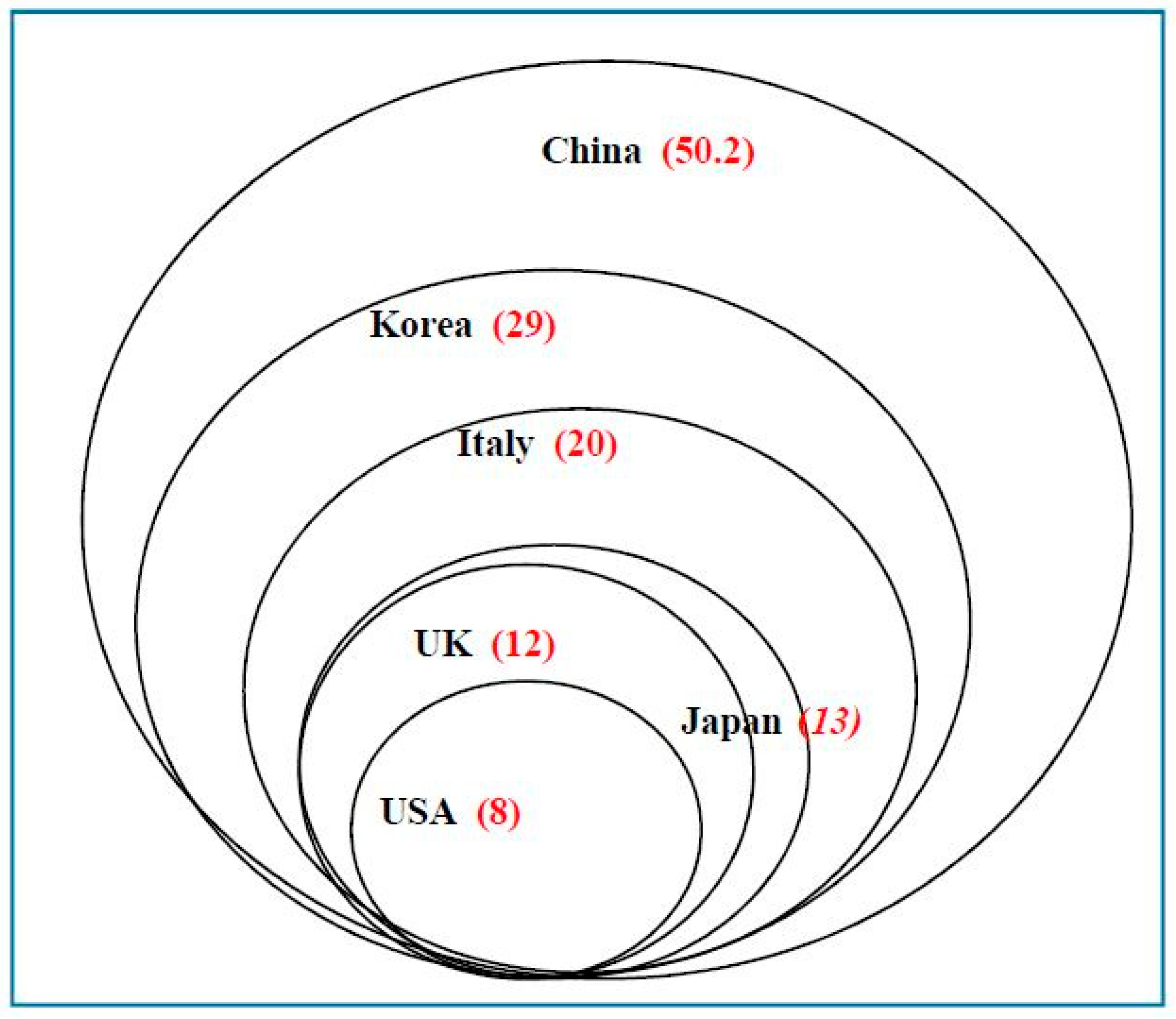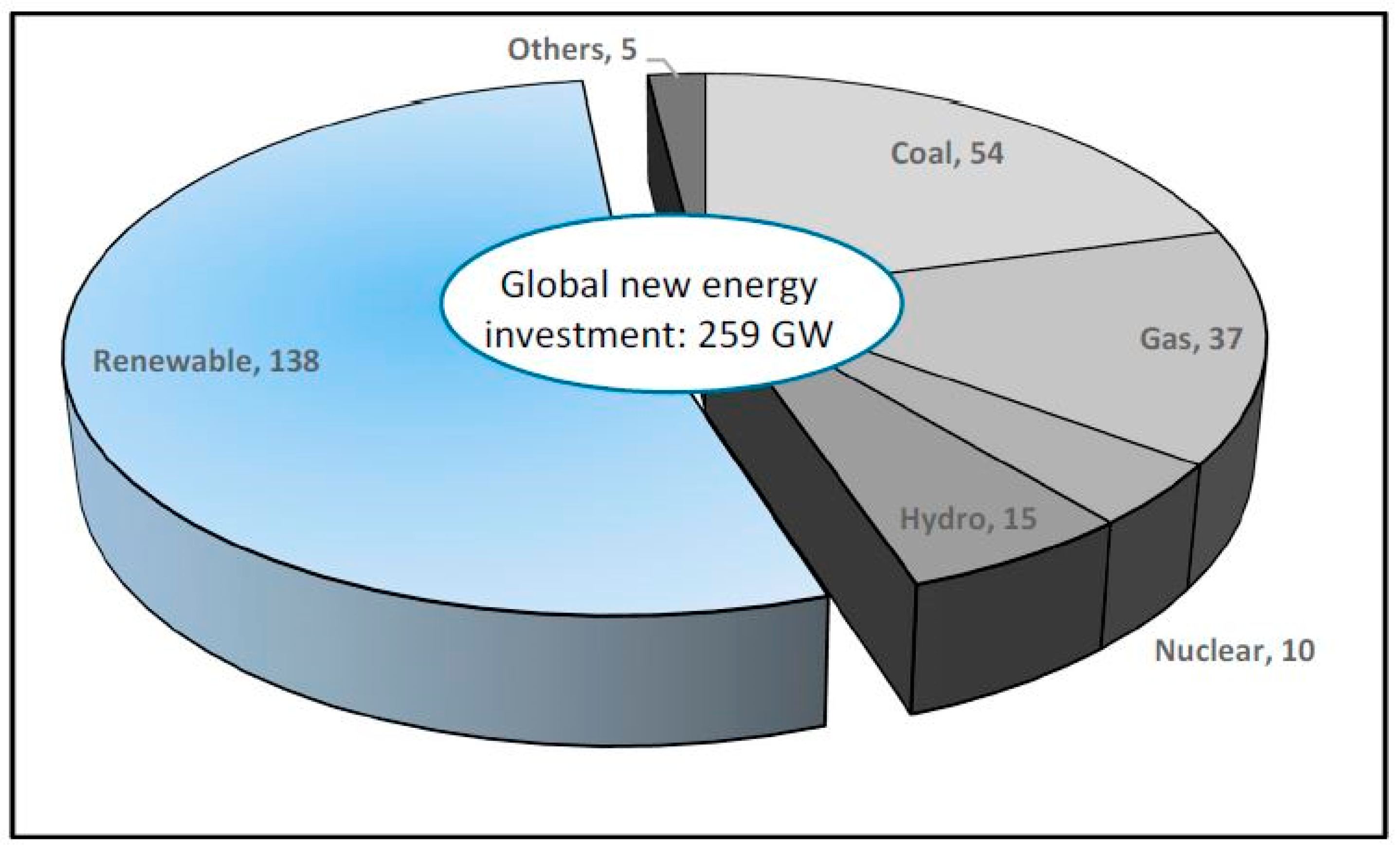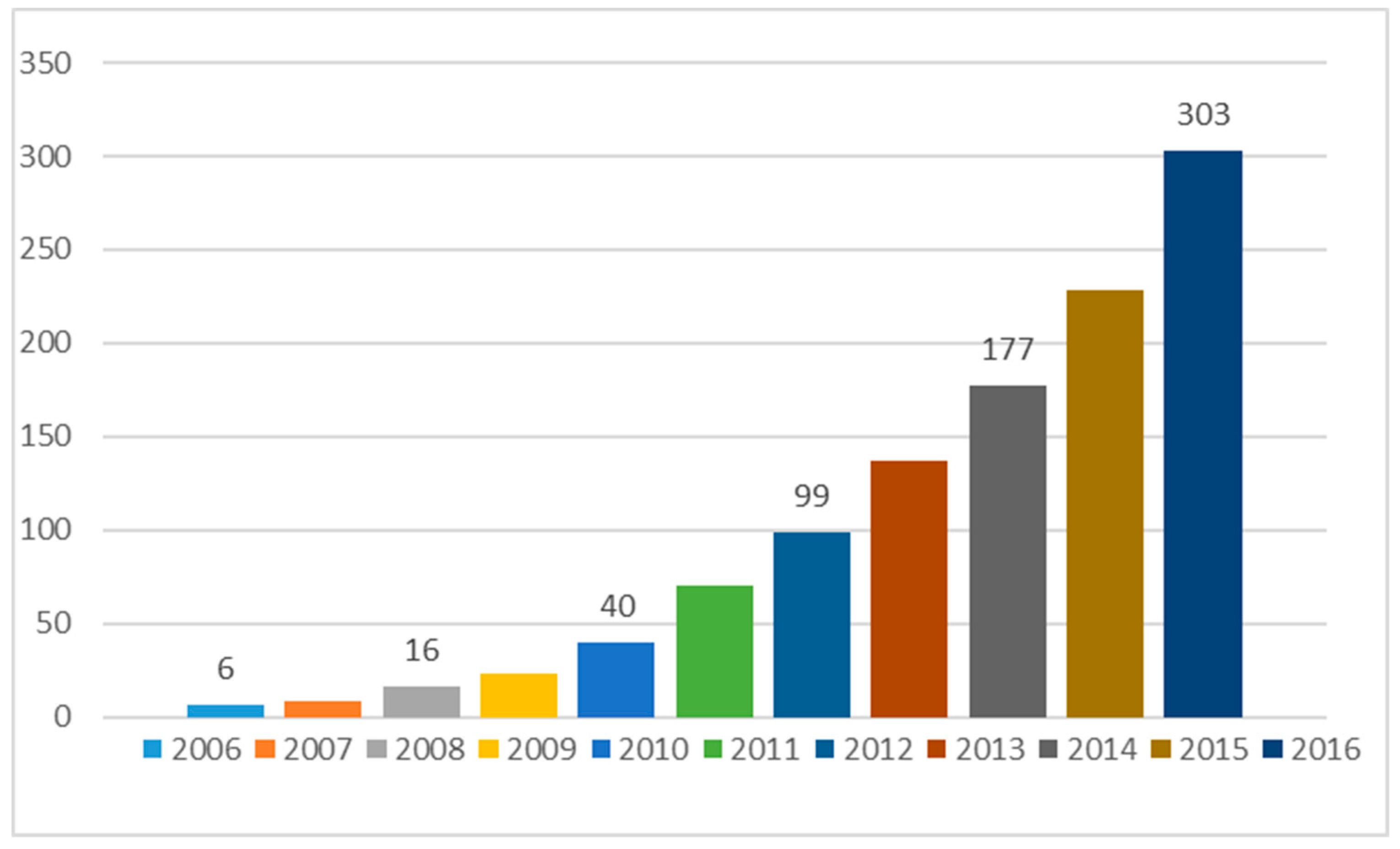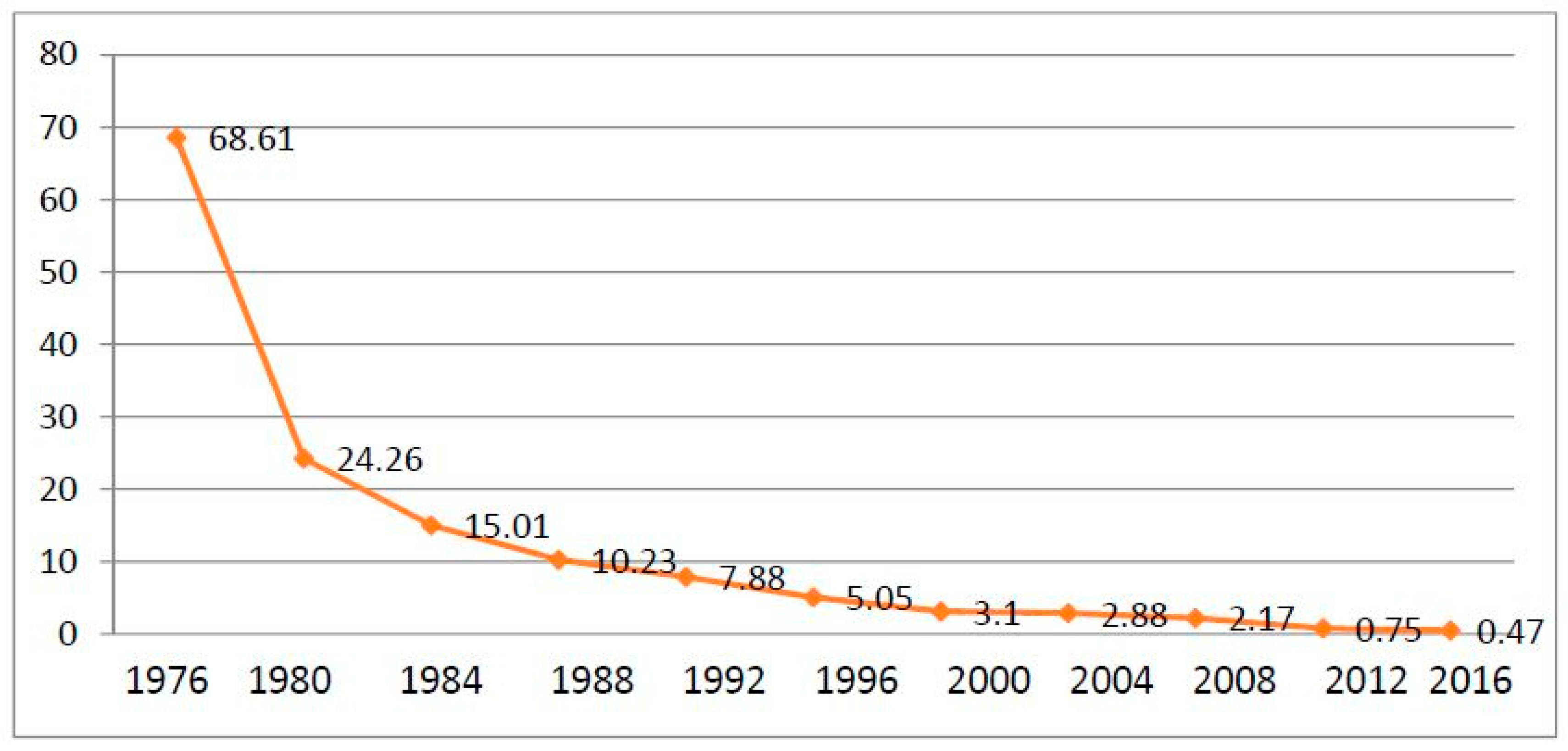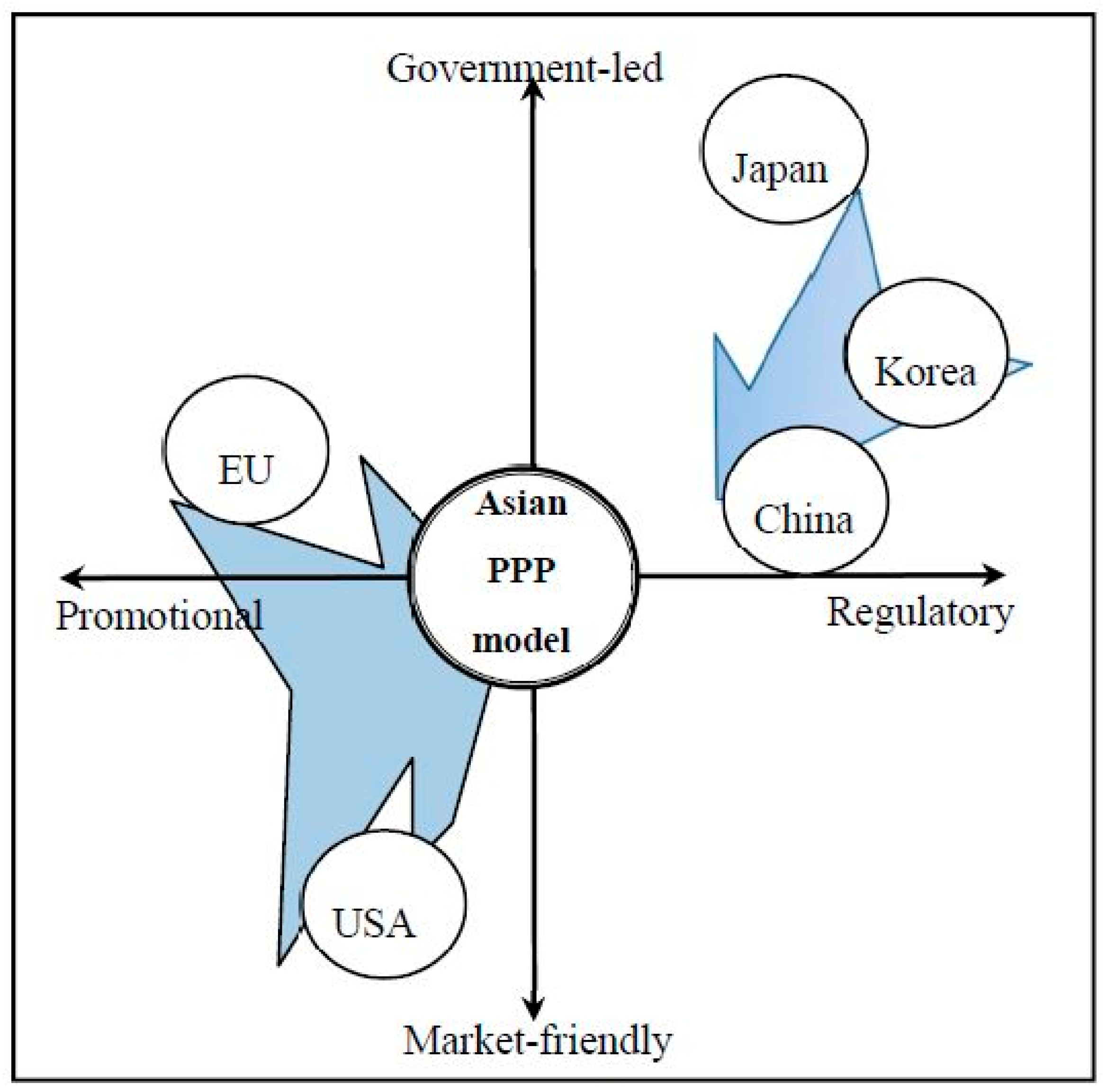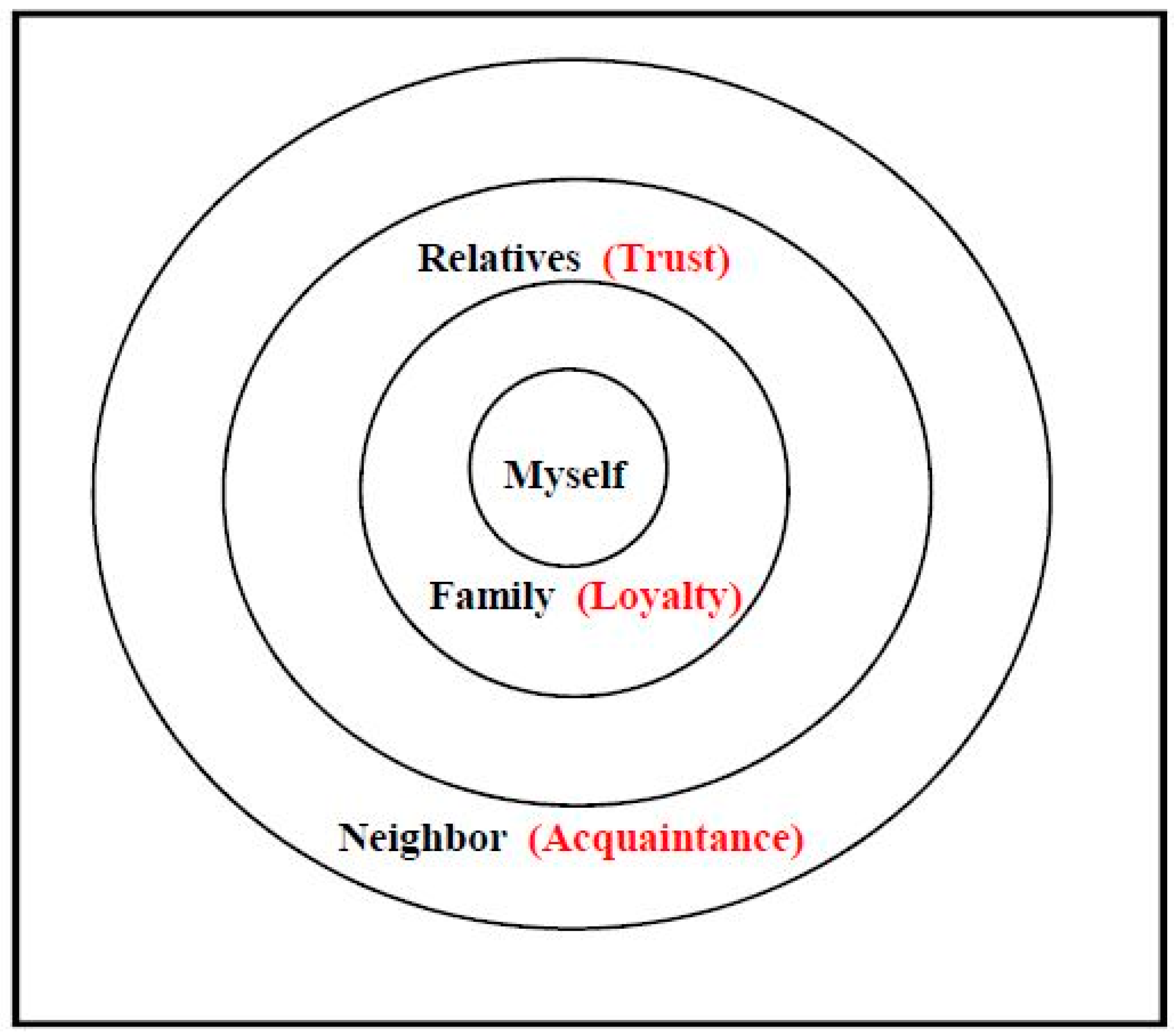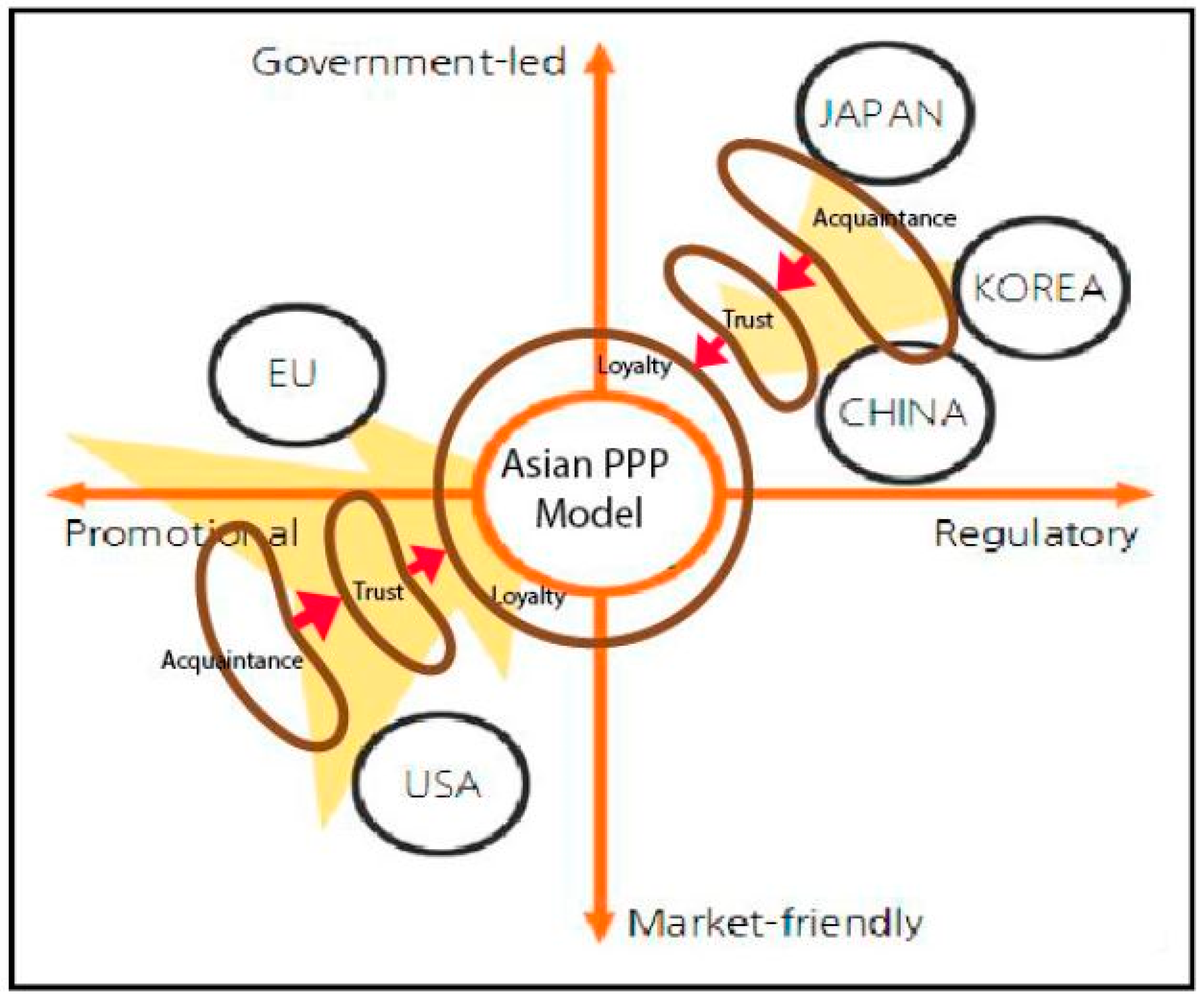2.1. Sustainable Governance Challenges of Asian Environmental Policies
The abysmal Fukushima nuclear power plant accident occurred on 11 March 2011. Seven years later, due to this nuclear incident, most major countries have changed their paradigm toward clean and renewable energy. Switzerland’s nuclear energy share is 35% at present, but after several referendums from 1979, the country finally declared in 2017 that no more new nuclear plants would be built from 2019, and aimed step-by-step to achieve a zero-nuclear society by 2034. Germany had 17 nuclear power plants in 2011, but declared a zero-nuclear society by 2022. Italy also initiated a zero-nuclear policy by 2022. Of course, Japan is also considering a significantly lower share of nuclear power. Certainly, due to the Fukushima disaster, an increased renewable energy share has become core to the future challenge. New investment in clean energy reached the record figure of
$360.3 billion in 2015, followed by
$324.6 billion in 2016, and
$333.5 billion in 2017. As shown in
Figure 2, most of this investment went to renewable energy in 2016 [
4].
Figure 2 shows the overall mix of global power generation investment. Nuclear power plants took only a 3% share of new global energy investment in 2016, while renewable energy excluding large hydro made up the majority of the new capacity added globally. The 138 GW of new wind, solar, biomass and waste, geothermal, and small hydro plants were equivalent to 53% of new additions for all generating technologies [
5]. Due to this transition toward renewable energy, the supply costs of these sources has decreased sharply. For example, the solar industry has shown a 50-fold growth rate from 6 GW in 2006 to 303 GW in 2016 (
Figure 3, [
6]). Due to the rapidly increasing investments in solar energy, the supply cost of solar energy decreased sharply to 5 cents per kilowatt, just 1/130 of the cost 40 years ago, as shown in
Figure 4 [
7]. Based on this booming trend toward solar energy, it is expected to have grid parity by 2022 [
8].
From these figures, we can conclude that investments in green technology for the abatement of GHG emissions become much more feasible over time. Unfortunately, we do not have enough time and resources to apply all of these technologies in our daily lives. Therefore, the role of the government becomes far more important for the development of these green technologies. Government policy has two directions, those of promotion and regulation. For free or low-cost technical measures, regulatory policies allow a much faster adaptation of the appropriate technologies, while high-cost technical measures may not benefit from severe regulation, but rather strong promotion through subsidies or tax incentives for the company to invest more in these green technologies. Depending on the cost-effectiveness of green technology development, the role of the government should be flexible, using regulation for low-cost or free technical measures, or promotion for high-cost technical measures. Of course, it is not always easy to determine whether policies should be regulation- or promotion-oriented. Inappropriate policy directions can sometimes aggravate environmental problems [
9]. The most representative policy failure can be found in diesel car promotion policies in Korea in the 2000s. The Korean government promoted the choice of diesel cars in the private sector with a range of incentives, including exemption from environmental taxes, because diesel cars produce very low rates of CO
2. Due to this incorrect use of incentives as a signal, foreign car manufacturers enjoyed rapidly increasing exports to Korea and the market share of diesel cars increased by more than 40% [
10]. In 2015, the Korean government found that PM 2.5 smog comes mainly from diesel cars, because while these cars produce low CO
2, they have very high NO
x emissions, which are a major cause of air pollution. Therefore, the government suddenly changed its policy from pro-diesel cars to anti-diesel cars. Soon, the government found that most microbusinesses used diesel cars in their operations and could not change these vehicles in the short run, resulting in further incentives. The government changed to using heavy environmental taxes. There have been confusing policy shifts between these two extremes of regulation and promotion. In the process, the Korean car manufacturing industry lost a golden opportunity to stimulate green technology development in electric and/or hydro cars. Due to this lack of consistent policies, Korean car manufacturing industries lost their future competitiveness [
10]. The reason for such policy failures comes from the fact that the policy-makers believe they are smart enough to lead the market, but do not understand that no policies can win against the market. The sustainable governance of environmental policy should come from the harmonized efforts of both public and private sectors.
Unfortunately, most papers on environmental issues conclude that regulatory policies will enhance environment-friendly efficiency, known as the Porter hypothesis [
9,
11,
12]. This may be true in the initial stages of green technology development, especially in developing countries such as China, but one-directional regulation may result in a range of harmful outputs, with the Kyoto Protocol providing us with an example of a top-down approach with partial success, despite resistance from the private sector. The Chinese government promoted the solar energy industry with heavy incentives, but this just resulted in an oversupply of solar panels and crowding-out effects on major leading solar companies around the world. Certainly, government-led transitions toward green growth are never easy or effective approaches without the strong participation of the market. A government-led economy as a leading environmental trendsetter, therefore, is not feasible. This implies that although most papers emphasize the regulatory role of the government, a government-led transition is really “mission impossible”. There were too many demonstrations against wind power facilities in Korea, for example. Most Korean people say “it is good, but not in my backyard (NIMBY)”, because it does not give any direct benefits, but only poses sacrifices for the public, such as loud noise, decreasing land or housing prices, etc.
On the other hand, subsidies for solar energy provided “blind, easy money” for solar technology developers and implementation companies. Meanwhile, most Korean households do not want such subsidies on solar energy, because it does not guarantee sustainable performance. If any new problems arise, nobody supports the maintenance of these solar facilities. The technology developers and/or installing companies obtain the subsidy funds regardless. This kind of “consultocracy” is a critical barrier in government-led economies such as China and Korea [
13] (p. 38). Here, consultocracy means that intermediary consultants argue over and confirm the feasibility of new systems, methods, and strategies for the market, without sufficient consideration of market factors, which include economic efficiency, company capacities, and technical interfaces with the legacy system. Therefore, to reach the goal of the Paris Agreement, the participation of the general public is also necessary. Without behavioral changes in the public sector, the mission of the Paris Agreement cannot be achieved, because the participation of the public constitutes up to 8.5% of GHG reduction targets [
14].
Based on all of these arguments, we should develop harmonized public–private partnerships (PPPs) based on Asian values of trust and loyalty to act as the trendsetter toward green growth. Why are these Asian values of trust and loyalty so important to sustainable PPPs? In order to answer this question, the conceptual characteristics of Asian values as guānxì will be examined more in detail.
2.2. Conceptual Characteristics of Guānxì
The environmental challenges under the Paris Agreement are really akin to mission impossible, due to the ambitious GHG reduction targets and the related risks arising from the unavoidably complex processes of sustainable development. In order to find the optimal control path toward this new 2020 climate regime, the most important governance focus should be on these public–private partnerships, because neither regulatory nor promotional environmental policies are effective unless all stakeholders voluntarily cooperate together to create value through sustainable performance. Since this new direction of sustainable development has not yet experienced a successful model for the global economy, Asian countries could become the new trendsetters toward green growth. Asian countries have strong common cultural virtues with respect to the community to which they belong. Instead of “I” or “myself”, Asian people prefer to use “we” or “ourselves”. This kind of “we can do it” spirit is very important for the successful governance of PPPs, and thus the cultural virtues of this kind of inspirational network could form the great cornerstone of Asian values.
The traditional paradigm of economics is based on economy or efficiency within the perspective of “I or myself”. Contrary to Western countries, as the terminology jingjixue or jingshijiminxue implies, the economics in Asian countries is based on the philosophy of “with people, manage the world”, meaning the sharing of future challenges among “ourselves”. In Asian countries, we find a totally different approach to economic issues: not to seek the competitive solution, but the harmonizing solution for all! This is one of the most common cultural factors in Asian countries. They expect professional economic leaders and their policies to be based on value creation for “our groups”; value sharing beginning from the individual, via family, local community, and government, up to the group as part of global society or humankind. In this social order, the most important virtue is the trust given to the leader and loyalty among the followers. It implies that, if the Chinese government sets up a new “Chinese Dream (Zhong guo meng)” then the people feel they have to show loyalty in following the indicated direction. This implies that China is based on a government-led economy.
In Japan, harmony is the most important cultural value, because meiwaku (being out of group harmony, or becoming a loose cannon) is harmful behavior for all and thus these kinds of selfish activities are forbidden. From elementary school, all Japanese people learn that they should not break the social invisible order, or behave against other people’s interests. In this kind of group or community-oriented society, individuals should not raise different opinions against the group or group leader. “Loyalty” to each person’s wider society is crucial for social relations. Compared with Chinese or Korean people, Japanese go one step further in this loyalty, because they believe in sontaku, implying that even if the other party does not give any specific order or direct command, they should know what they need to do for the other party from the surrounding conditions and historical context. This kind of strong interrelationship creates invisible values of sharing responsibility, as well as establishing the rights of the group. This kind of oyabun–kobun (leader–follower) relationship is very important in meeting predictable future challenges. Even if the government or company leader sets impossible future goals, the people following them do not complain against this direction and do their best to promote the policy or business strategy with all their efforts. Therefore, Japan can be clearly categorized as a government-led economy, due to this cultural background.
Despite the many demonstrations on the street against government policies, Korean people also have strong cultural values of loyalty for “our community or our group”, and this kind of “we-spirit” is crucial for Korean people to engage in group-oriented activities. When the IMF (International Monetary Fund) foreign currency crisis struck in 1998, the Korean people all sold their gold rings, gold medals, and gold-made precious items in return for US dollars, and this formed a great stepping stone for the Korean economy to undergo all the painful restructuring required to achieve an advanced economic structure. In 2002, the Korean people spoke with one voice of applause for the World Cup football tournament in Korea and the global population witnessed this fever of “we are the one!” enthusiasm in the streets, in schools, in businesses, everywhere.
Compared with the Western countries of the United States and the European Union, which have adopted market-oriented, promotion-based environmental policies, the northeast Asian countries follow strongly government-led, regulation-based policies, as shown in
Figure 5.
Figure 5 indicates that the northeast Asian countries are based on strongly government-led top-down environmental policies. As discussed above, however, such government-led policies may result in a consultocracy, with resulting policy failures, due to a lack of adequate business knowledge and market-oriented experience. Without the strong support of the private sector, it is almost impossible for governments to promote sustainable development. In 2018, for example, the Korean government faced unworkable recycling challenges with vinyl plastic materials. The Korean government implemented a volume-rate disposal system from the year 1995 that requires residents to purchase and use special trash bags [
1]. All trash has to be disposed of in state-authorized plastic bags that were made available at local stores. However, the recycling of materials such as bottles, cans, and vinyl plastic bags is exceptional. These materials were free in terms of the consumers, because the producer’s liability (PL) law will pay a priori for these materials for recycling. However, due to the massive effort required for these recycling processes, the recycling companies claimed that they could no longer collect and process vinyl plastic, because most of the vinyl was too dirty and too sticky to clean and recycle, so the costs were ever-increasing. There are many reasons for this lack of governance with regard to vinyl recycling. One of the most important reasons arises from the consumers’ negligence in undertaking vinyl plastic waste disposal. Using the same system, Japanese people are very considerate in disposing of vinyl plastic bags. They clean most of the vinyl before they throw it out, making it easier for the recycling companies to decrease the effort required to handle the recycling process. The difference between Korea and Japan lies in the behavioral effectiveness of the population. Japan does not have any problem with the proactive participation of consumers, while Korean consumers think it is “none of my business”, and because it is free, they do not care about the disposal process. Therefore, the interrelationship between public and private sectors is very important to achieve better performance in environmental policies. This is the background of the Asian approach to these kinds of undesirable outcomes of environmental policies, in terms of Asian PPP models with the governance factor of loyalty as an Asian value.
In terms of Asian values, the most important governance factors should be based on interrelationships. To promote mutual benefits, the traditional paradigm underlying the feasibility of policies or business strategies in Western society is based on “trust,” while in China,
guānxì is the most important factor for new business, new projects, new policies, etc. [
16] (p. 412).
Guānxì is the most important value for interrelationships in northeast Asian countries, because it provides a strong stepping stone to enter the cooperative network easily and effectively. However, for most people in Asia, and even in China,
guānxì is misunderstood. In general, it is interchangeably used with “connections” or “relationships”, while neither of those terms sufficiently reflects the wide cultural implications that
guānxì describes in China or Asian countries under the cultural background of Confucianism [
17].
In Asia,
guānxì is key for the feasibility of new policies, businesses, and any type of new project.
Guānxì is different from simple trust, in that the latter emphasizes horizontal, bidirectional belief, while the former focuses on diverse, stepwise, mutually beneficial interdependence.
Guānxì also acts as an essential informal governance mechanism, helping leverage Chinese organizations on social and economic platforms [
18]. When business interactions are less efficient to facilitate,
guānxì can serve as a way for businesses to circumvent such institutions by having their members cultivate their interpersonal ties [
19]. Of course, sometimes the
guānxì network may also violate bureaucratic norms, leading to corporate corruption [
20]. Therefore, sustainable governance in
guānxì is so important.
The ideal of
guānxì can best be found in the inaugural meeting of three historical heroes in China (
táoyuán jiéyì). Even though they all came from different families, they made a brotherhood commitment to share their futures. As shown in this famous case,
guānxì is not just human relationships or social networks to share trust within China or other Asian countries, but the basic “social platform” for the economic system, as well as the core of business activities. One famous Chinese researcher, Fei Xiaotong, defined
guānxì as a “tidal wave” style of social relationship, as shown in
Figure 6 [
21]. To illustrate, all of the social activities surrounding myself can be supported by orderly stepwise
guānxì (
chaxù géjú): from the lowest level of friendship with my neighboring people, which gives simple acquaintance as a social contact point, via relative-oriented
guānxì with the fellowship of mutual trust, to the highest level of family membership with full loyalty. The lowest value of
guānxì is based on the easy and effective ability to communicate with each other, at least in the initial stage of cooperative projects, while the highest value is loyalty, which is the cardinal Asian value in PPPs.
People use one of these or combined
guānxì qualities in relation to other parties. If all of the other parties are in the category of the highest level of loyalty-based
guānxì, then one should not have any difficulty in achieving cooperation, while with the lowest level of friendship-based
guānxì, you may have a limited degree of easy access to a new project but cannot expect more difficult or uncomfortable decisions from the other parties. Sometimes, this kind of spiral
guānxì can be defined as initial trust and ongoing trust; and ongoing trust can be interpreted as sustainable loyalty [
22]. Therefore,
guānxì is the core of sustainable governance for collaborative new projects. If you know your partner in depth through the recommendation of your intimate friend or family member, you will devote more effort to cooperate with this new partner, even in unknown projects. Fei Shaotong and Choi clearly defined
guānxì as comprising diverse levels of value-sharing in social networking, and thus effective network management could be crucial for the successful and sustainable performance of green growth policies. Therefore, governments or local communities in Asian countries should encourage the private sector to enhance its
guānxì toward all relevant interest groups. The aim of people in the
guānxì network is not that of maximizing profits or efficiency, but rather acting as partners to create value based on voluntary innovation to enhance their positions in this radiating wave type of
guānxì.
The most important character of guānxì comes from value sharing. It is a mutually beneficial relationship with the slogan, “If you make me a hero, I will make you a hero”; in this respect, it is very similar to the “give and take” spirit of Western society. However, guānxì is much more diverse in its contents and deeper in the responsibilities of the relationship. The second characteristic of guānxì is more functionally oriented in its effect on social activities. It does not clearly show the level of loyalty in a given social relationship and it does not guarantee any responsibility arising from a guānxì-based recommendation. Nonetheless, guānxì excludes any free rider problems, because if you fail to meet expectations, all the related parties may have damage to their guānxì, resulting in mutually worsening outcomes, which makes the parties to the guānxì relationship work better. The third characteristic of guānxì is based on the indirect nudge effect, implying the use of positive reinforcement and indirect suggestions as ways to influence the behavior and decision-making of groups or individuals in new projects. Even if there is no clear or direct content conveyed by guānxì, it provides diverse areas for the related parties to consider. In Asia, without any specific written relationship, guānxì may sometimes create even stronger effects in very flexible ways. Finally, guānxì is based on the membership of one’s own community or group, and thus the success of the community or group should take precedence over individual success. Individuals are ready to enhance guānxì by serving its leadership with more contributions, or sometimes making sacrifices for “our group or our community” as a larger family. In the famous story of three heroes in the three-country Chinese legend, Zhu Geliang died for Liu Bei and his son because of his strong brotherhood type of guānxì. This ideal type of guānxì is very influential for all Chinese people in their social activities.
Unfortunately,
guānxì is not easy to create, maintain, and utilize as social relationships for sustainable performance. However, if we have strong
guānxì for a new project, it is much safer and easier for the parties to perform in more effective ways. One of the most important tasks is establishing how to create and manage
guānxì, especially for the risky and uncomfortable future challenges of sustainable development in stepwise progression starting from acquaintance, via initial trust, until the in-depth loyalty of Asian values has been achieved, as shown in
Figure 6 and
Figure 7. In order to find the optimal path toward the Asian PPP model as a collaborative network, the following Section will propose strategies for network management, transforming the government-led economies to move along this optimal path of governance.
